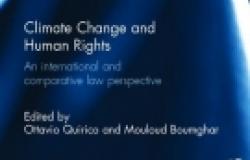Book Review: Climate Change and Human Rights: An International and Comparative Law Perspective

Climate Change and Human Rights: An International and Comparative Law Perspective, edited by Ottavio Quirico and Mouloud Boumghar. Abingdon and New York: Routledge 2016. 410 pp, £90 hardcover 9781138783218
Having worked on and researched in the field of climate change law and politics since 1989, I have witnessed the rise of the leadership concept as a way for the developed countries to reduce their collective greenhouse gas emissions substantially, allowing room for the emissions of developing countries to grow somewhat before the eventual phasing out of all such emissions. While this concept raised hope and brought countries of the North and South together in the early 1990s, the lack of consistent leadership and lack of substantial reduction of emissions from 1990 levels by the developed countries calls for alternative justice approaches to address this challenge. One of the numerous options being discussed in the literature for at least a decade is the human rights approach. Ottavio Quirico and Mouloud Boumghar provide in this edited volume a state-of-the-art assessment of the human rights issues so far.
Their four-part book discusses the general framework of human rights, the elaboration of specific rights, the discussion of rights and climate change in relation to specific regimes, and the prospects for institutional development of these rights.
In terms of the general framework, Chapter 1 argues that a human rights framework may either mean an obligation not to take action that interferes with the fundamental claims of people (i.e. a negative right as used in the Inuit case before the Inter-American Court on Human Rights); a duty to ensure that human rights are not violated by measures aimed at prevention and punishment (i.e. a positive right as used in a case filed by the Arctic Athabaskan Council at the same court); or thirdly when states take mitigation or adaptation action which breaches human rights. In implementing climate related responsibilities, the state needs to respect human rights (i.e. it needs to ensure that actors meet GHG emission limits), protect human rights (i.e. it needs to intervene to prevent or punish violations of human rights), and fulfil human rights (i.e. it needs to take measures to realize the claims of people). However, implementing is challenging, as states may have discretion in the implementation of their measures; it is often difficult to ascertain the extent of responsibility in relation to transboundary measures; the chain of causation is not clear; and there is difficulty in imputing responsibility to a specific actor. So far the book spells out issues that are generally well known to the human rights scholar. However, it then goes on to argue that the human right to sustainable development is similar to the customary no harm rule in combination with the precautionary and polluter pays principle, only seen differently (p. 35).
Lewis argues in Chapter 2 that mitigation (e.g. through land use change to grow biofuels) and adaptation measures (that inadvertently lead to forced displacement) can also violate human rights measures. Riddell shows in Chapter 3 that there are increasing arguments regarding the human rights responsibility of private corporations, although this is difficult to actually implement because the responsibility of these corporations is often seen as ‘soft’ in law: namely the 2011 revisions of the OECD Guidelines for Multinational Enterprises – which calls on multinationals to recognize human rights and contribute to sustainable development; the 1999 Global Compact; the 2007 Caring for Climate Framework, the 2003 Norms of the UN Sub-Commission on the Promotion and Protection of Human Rights, the 2003 Equator Principles, and the 2011 Ruggie Principles on Business and Human Rights.
Part II looks at specific rights. It argues that although climate change can violate the enjoyment of the right to life, it is very difficult to actually invoke this right (Chapter 4); although climate change affects the rights to water, food and health and hence requires measures to mitigate and adapt, this is difficult to implement, but not unimaginable (Chapter 5); although climate change and sea-level rise can affect statehood and self-determination, something not envisaged by the Law of the Seas, this needs further reinterpretation (Chapter 6); and although climate change could potentially violate the right to development by exacerbating inequalities, ultimately it calls on all countries to achieve sustainable development (Chapter 7). The last chapter in this section argues that the human right to a climatically sustainable environment is an evolving concept, not yet fully recognized or articulated, but that “it would permit transcending the traditional notion of human rights as an individual entitlement and capturing the intrinsic collective and global dimension of climate change and its inter-generational nature” (p. 155).
The third section looks at various climate-related regimes. It argues that where climate change causes biodiversity loss, such loss could also affect the actual enjoyment of individual and community human rights, where the latter refers to the rights of indigenous peoples (Chapter 9). Furthermore, it is argued that climate change may give rise to a new category of people that deserve protection – climate migrants/refugees; however “group-specific protection of environmental or ‘climate’ migrants runs the risk of being only a palliative measure delaying much needed responses to structural deficiencies of the international governance of migration” (p.188). At the other end of the spectrum, climate measures could affect the rights of investors, both to their property and to the fair and equitable treatment standard; this requires a careful balancing between their rights and general human rights (Chapter 11). It could also seriously affect trade; this too requires a coherent approach to international law which links climate change with trade but does not allow for emission related conditionalities that can be misused for protectionist purposes.
The overall message of the third section focuses on better coherence between different legal systems in order to minimise violations of human rights while not creating new problems. Section IV then logically looks at institutional prospects, arguing that while the Climate Convention and the UN Human Rights Commission both try to address implicitly and explicitly human rights violations respectively, clear links between the two have been hampered by the oil producers and users (Chapter 13). At regional level the Asia Pacific region has a long way to go to actually develop relevant human rights regimes (Chapter 14), the African region has developed institutions but with limited effectiveness (Chapter 15), the Inter-American region has advanced human rights regimes, but case law on climate change and human rights has yet to be developed (Chapter 16), and the European system unsurprisingly has the most developed regime in this field (Chapter 17). Within domestic jurisdictions, a series of cases have emerged that challenge state and private corporation actions for human rights violations; these show that while the database on climate change related cases is relatively small, there has been a start to using domestic legal systems to demand justice (Chapter 18).
Addressing climate change clearly needs a carrot and stick approach. Carrots or incentives need to be complemented by sticks, and preventive and punitive measures for human rights violations are one such tool. While the general motivation of the authors aims at protecting humans from human rights violations, they all tend to agree that the legal community will have to develop the legal regimes considerably before this stick becomes an effective deterrent for states and private corporations in respect of their greenhouse gas emissions. This book is a deep, well developed analysis of human rights and climate change and is highly recommended to those interested in the development of climate change law and politics.
While recognizing the importance of this book to contributing to clarity in the field of human rights law and climate change however, I regret the inability of legal scholarship to rise beyond positivist and reactive analysis to propose structural innovations in the legal field, in order to be far more creative and proactive in dealing with the problems that capitalism, current development approaches, and the runaway developments in technologies raise. Legal scholars are locked in their positivist paradigms; they run the risk that the legal system will be substantively overtaken by the realities on the ground and will not set the rules within which the realities must function.
Joyeeta Gupta is professor in Environment and Development in the Global South, at the Amsterdam Institute of Social Science Research, University of Amsterdam.
Out now, Global Policy’s fourth e-book, 'Climate Change and Human Rights: The 2015 Paris Conference and the Task of Protecting People on a Warming Planet', brings together world-class academics and practitioners to explore how to set the stage for coping with climate change before it is too late. To buy the e-book for your Kindle, e-reader or as a PDF for $9.99 please click here.


